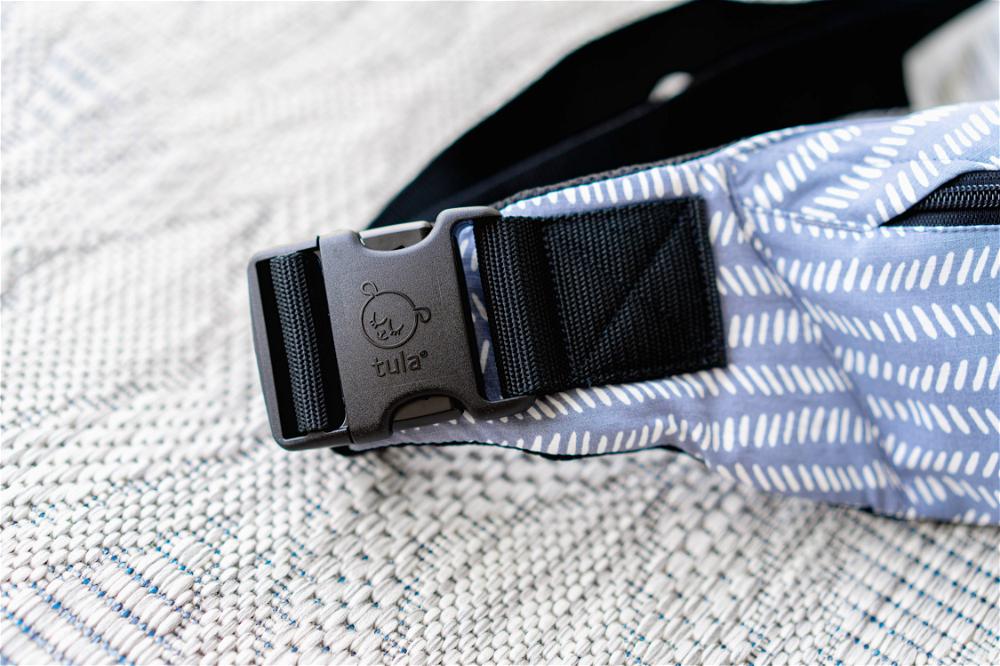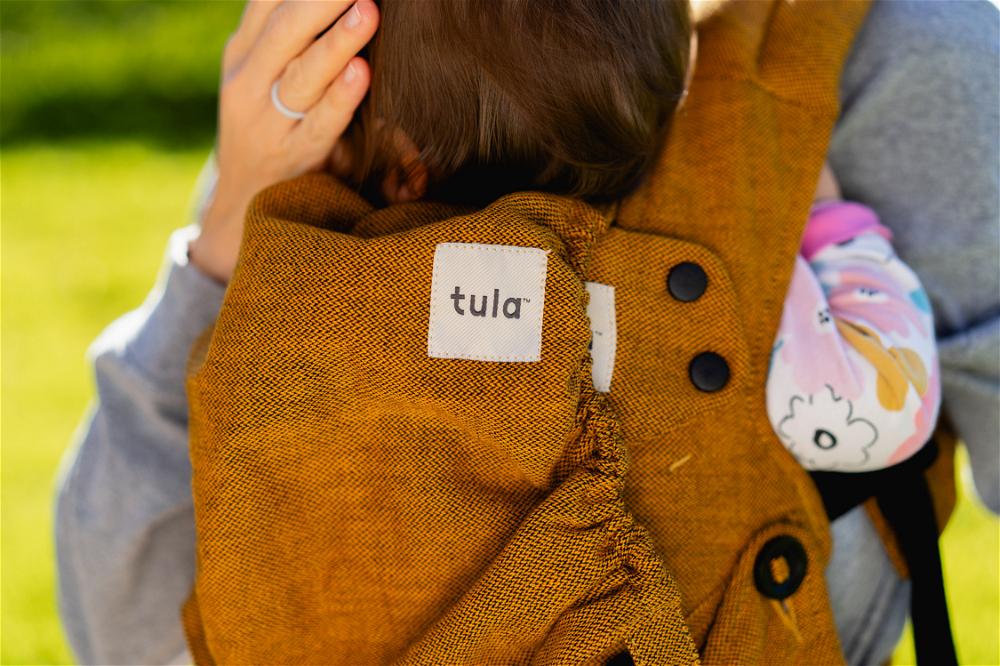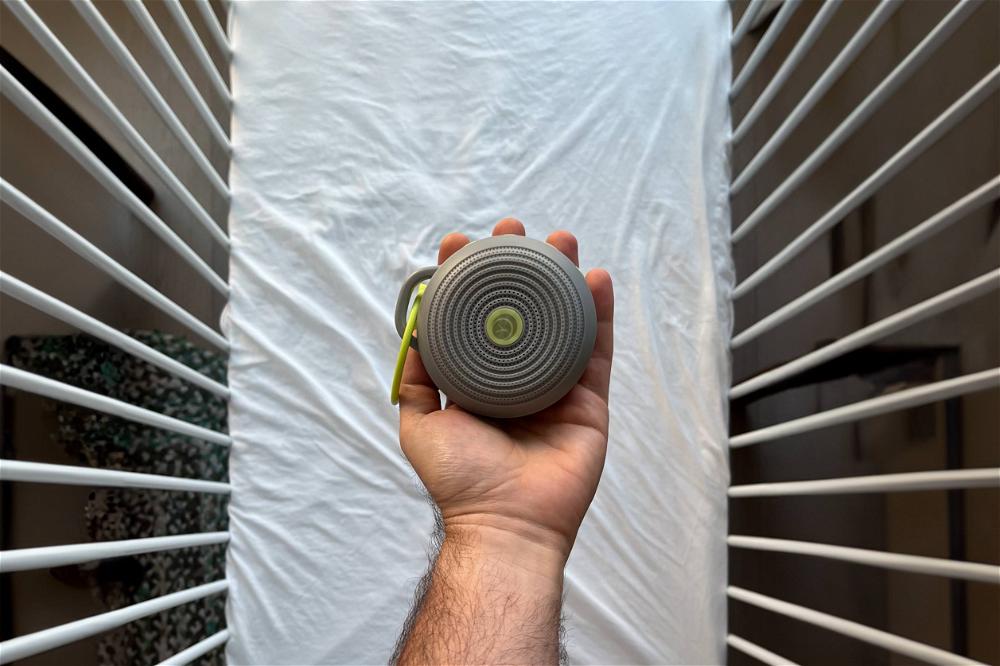4 Best Hiking Baby Carriers: What to Know about All the Main Brands

When it comes to baby and toddler hiking carriers, there are only 4 brands to consider! In this review, I break down the differences in these products so that you can make an smart choice.
This article may contain affiliate links. We earn a small commission when you purchase via those links — at no extra cost to you. It's only us (Becca & Dan) working on this website, so we value your support! Read our privacy policy and learn more about us.
For months, we went hiking when summer finally came around and our baby was in the 6-8 month age range. Given her small size, we fared great with baby carriers like the Baby Bjorn Mini, Baby Tula Carrier Lite and the Baby Tula Explore carrier, as she grew a little bigger.
But what about when you either really want to get onto those trails with your child on your back, or you want the most steady and sturdy hiking backpack to put a toddler in?
In this list, see the best of the best child hiking carriers, also known as “baby hiking backpacks.” I’ll tell you which baby carrier for hiking we ultimately went with (and why we like it), as well as the other options out there. We’re not including ANY poorly-rated carriers, or any from brands that aren’t top performers.
Luckily, to avoid overwhelm, there are really only 4 main brands to consider! Let’s begin.
Deuter Outdoor Child Carriers for Hiking (Kid Comfort Pro Line)
Spoiler alert! We have a Deuter child hiking carrier and we started using it when our daughter was a little over a year old. That’s when spring came around and hiking season began for us as a family of three. We got our Deuter Kid Comfort hiking carrier even before she was born, so we were super excited to use it.
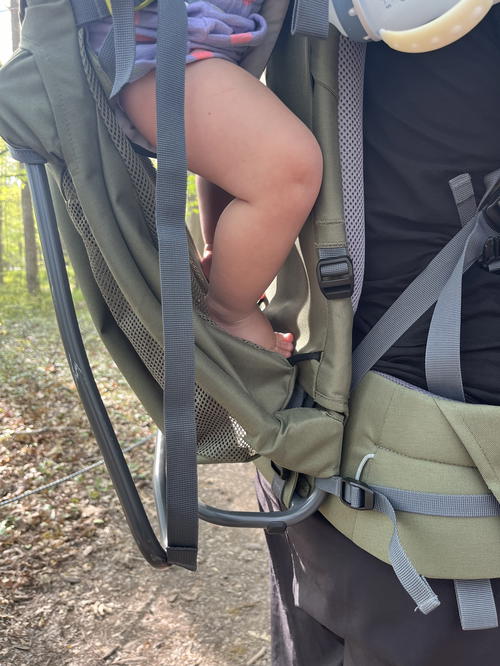
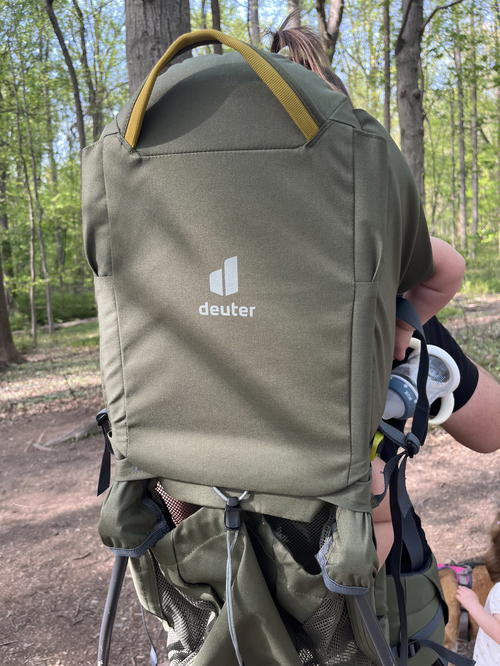
What we like
Of course, we like that Deuter is a very well-respected brand in the outdoors, hiking and adventure space. Here are a few factors that we think set it apart:
- It’s attractive. It’s pretty simple, and looks good. When we use it, it looks like a heavy-duty baby carrier product, and it means business.
- Padded hip belt: this is great for weight support when you’re getting used to having a toddler on your back (as well as hiking uphill!).
- Fully vented back support system: Deuter is really good at making products that sit well on your back and help manage a load. We find it comfortable.
To see all our photos and detailed thoughts on a Deuter child hiking carrier, head to our Deuter Kid Comfort Pro carrier review.
(Below: using the Deuter Kid Comfort hiking carrier year-round, in both fall and spring)
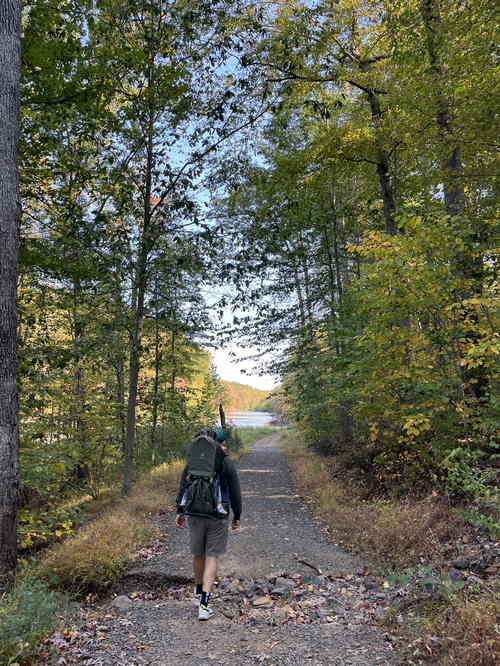
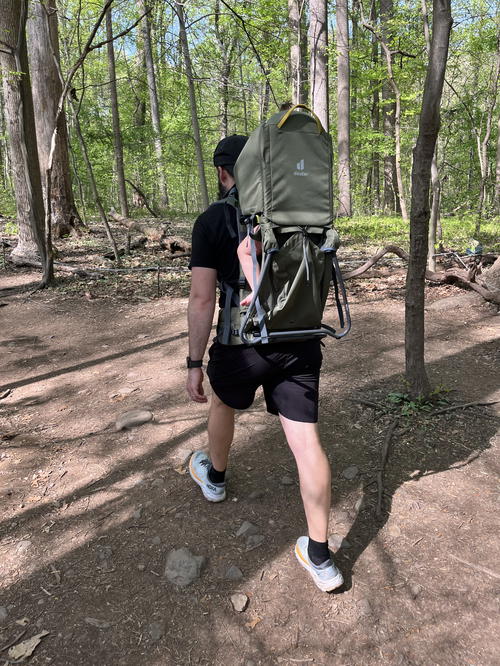
What we like less
- Total weight when empty: Deuter child hiking backpacks range from 6-7.83 lbs when empty. This is middle of the road when it comes to comparing them against other brands.
- They don’t come cheap. Most start in the high $200-range and go into the $300+ range. Then again, no one should really be skimping on a product that keeps your child safe while HIKING!
- The kickstand is a bit stiff to get out, and then close back in. It takes practice.
- It takes up a lot of space in the car.
(Below: our Deuter Kid Comfort child hiking carrier, empty, folded up and brand new, when we first received it in the mail)

Overall, we’ve recommended the Deuter Kid Comfort hiking carrier to countless numbers of parents.
Our daughter thinks it’s fun, and we think it’s fun to take her along to see nature and be “tall.” My best advice is to make SURE that when you “switch parents,” that you make all the proper adjustments in the hip belt, sternum strap and back support straps to have an ergonomic experience.
One last great reason to get it
Deuter has a “lifelong” repair service; the company really wants to keep your Deuter product out of trash and landfills, and will work with you on fixing it if it breaks. They believe in strong and committed customer support and unlike other brands, they’ll repair your Deuter product FOR FREE, even if the issue was totally your fault.
I have not seen other brands doing this. Usually warranties are limited to manufacturing defects, and you’d be at fault for anything you did to your hiking carrier. Not Deuter, though, and that’s a reason to stick with this great travel brand.
Osprey Child Carrier Backpacks (Poco Line)
If you’ve ever done some backpacking as a 20- or 30-something, you’ve likely seen lots of Osprey backpacks on the road. I know I have. And I’ve listed some of their larger-volume packs as top picks in my list of the best travel backpacks for women.
Osprey Child Carrier Backpacks (the “Poco” collection) come in four models. The most basic and affordable is the Poco SLT, starting at (currently) $250. Next is the Poco LT, and the difference that I see between those two is just the sunshade for now (included with the LT, and suggested as an a la carte add-on with the basic SLT model).
Getting more elite is the Poco™ Child Carrier, which is priced at $350 for now (but sometimes on sale at REI!). In the more expert range of the Osprey carriers, the “child cockpit” gets more deluxe, and heavier, too.
Finally, the Poco™ Premium Child Carrier, is close to $400 and will give you every fancy feature like a “fully-framed child cockpit” that is totally washable, with an anatomical fit, adjustable seat and safety leg loops.
Reasons to get one
I’ll start off with this: being that I’m a 5’2” woman who is short with a narrow frame, and I want to be included in the demographic of hikers who can support the weight of both a small toddler and a hiking carrier, the weight of the Poco SLT basic carrier model at ONLY 4.72 lbs. is highly attractive. There, I said it: this is the lightest carrier in this list.
Just like the other trusted brands in this list, Osprey’s hiking carriers can all support close to 50 lbs. of total weight (48.5 lbs. at maximum is the spec recommendation).
Parents who’ve been Osprey fans for years will like the Osprey brand that’s pretty apparent all over any of the four hiking carrier models. In fact, there’s some nostalgia that these hiking carriers for parents actually remind me of the big “backpacker bender” 50, 60 and 70-liter backpacks I used to see in backpacker hostels. Those were the days (see my backpacker nostalgia story).
There’s also a great assortment of pockets on all Osprey’s models of baby hiking carriers. I can assure you how handy that is for parents, because when we’re hiking as a family, I’m nearly always reaching into the hiking carrier to get something.
Reasons to pass on them
Tall parents actually say that the Osprey carriers are NOT the best for tall people, which is surprising! My recommendation is to go to a store like REI to try a few of them on, if your’e exceptionally tall, and to see which one works.
Criticisms from short or narrow parents are that the heavy carriers like the Poco Premium, which is closer to 8.4 lbs. when empty, are tough to use. I think I’d agree with that regardless of the brand.
Overall, the Osprey child hiking backpacks are well-loved in the family hiking community, so there’s not much negative to report home about.
Thule Child Carrier Backpacks (Sapling line)
The Thule Sapling line is not big: okay, actually Thule makes one baby hiking carrier called the Sapling Child Carrier, and it comes in two colors. For now, Thule makes only two accessories for it as well: a rain cover, and a “sling pack,” which is an add-on backpack item for parents. It’s pretty simple.
And that’s why shopping with Thule is nice, actually. There’s one choice, and it’s good. It’s also pretty pricy, at nearly $400 for the Thule child hiking carrier.
But the reviews are rave, so Thule is doing something right.
Reasons to get it
It has a minimalist and upscale design that parents will love. There’s generous storage under the child seat, a cool mesh suspension for the baby or toddler, a slim sternum strap for the parent wearing the entire product and a very padded hip belt.
Also, it’s easy to clean, and that comes as a plus. The entire carrier is straightforward, with no confusing straps, buckles or compartments. The child “drool pad” and the seat come off for washing (and you never know when there could be an accident).
Another plus is that you can put a child in from the top, or from the side. This is nice for some kids who don’t like being loaded from the top, or, for if you prefer to get the child in before you put on the carrier, versus when it is already on your back. There are options.
Lastly, the sun shade is built in. It’s not an add-on, like the ones from others brands. And even more lastly, it weighs 7 lbs, so that’s less than most of the more expensive Osprey models.
Reasons to pass on it
It’s pricy. And the accessories are a bit pricy too. If you got the Thule child hiking carrier and one of the accessories, you’d be spending more than $400.
Kelty Child Carrier Backpacks (Journey line)
Whereas Osprey and Deuter are known more for their bags and packs, and Thule is known for heavy-duty products like “racks” and RV accessories, Kelty is a camping and backpacking brand. So, it would make sense that the company makes 3 hiking carriers for children, starting with a basic model and going up to a premiere model.
All three Kelty child hiking carrier models, known as the Journey line, fit up to 50 lbs. of weight. What’s great about the most basic model, the PerfectFIT Child Carrier, is that it’s affordable (under $300) AND weighs less than 7 lbs. when empty (in fact, it is 6.37 lbs., thereby beating out a lot of the competition).
Reasons to get one
The design of the Kelty hiking carriers is different. To me, it looks “more” suspended than the other brands, and I can’t quite explain it (especially the PerfectFIT basic model).
Some nice features are the stirrups for the child riding in the seat, along with a wide seat base (compare to the Deuter, which is more narrow at the child’s bottom) and a 5-point safety harness to keep a toddler in place.
For parents, there’s the PerfectFIT™ Suspension System for easily adjusting mom’s fit settings, to dad’s, and back.
On the upper model, the Elite Child Carrier, the large backpack-style pockets at the rear of the child’s back can fit a lot: layers for everyone, plus snacks and first aid essentials. And the hip belt has zipper pockets too (I’ve found this feature to be helpful on all larger-load backpacks I’ve owned).
Reasons to pass
Common shortcomings of the Kelty hiking carriers are that they’re best suited for people of average height and shorter (good for someone like me, but not my super-tall friends). Also, due to the relative shallow-ness of child seat, the carrier itself may be suited best for children who are not on the tall end of the range for their ages.
My original gut feeling when I saw the design of the Kelty carriers was correct, aligning with one of the more common criticisms of this product as well: the carrier leans toward being “top-heavy.”
How to choose a child hiking carrier
There’s no “wrong” child hiking carrier to buy. They’re all awesome. There are some reasons to pick one over another, though.
And if you’re not ready to take the dive into investing in one, or, if your child is still under 12 months and you don’t have a sturdy travel baby carrier yet, head to our list of the best baby carriers for travel, first.
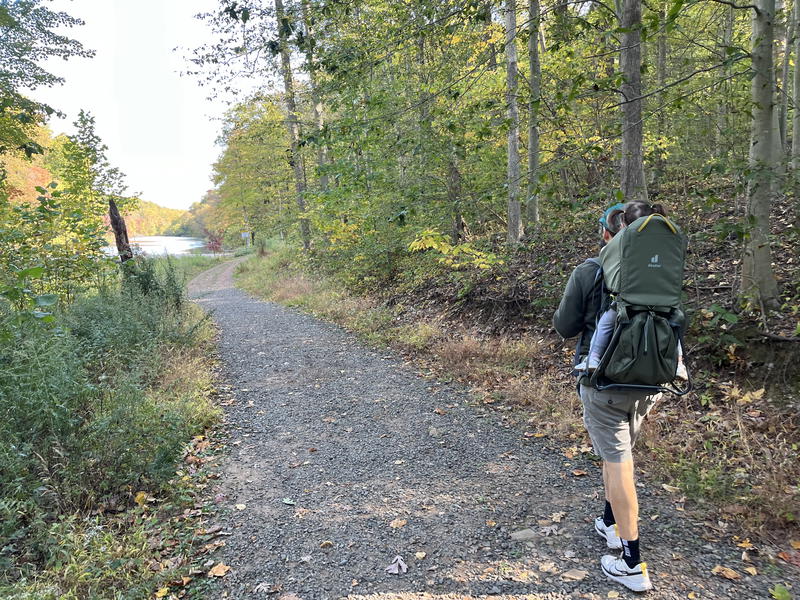
Price
After doing all the research, I found that child hiking carriers simply don’t come cheap. If you have a set budget, for example maxing out at $250, you may be boxed in to the Poco™ SLT from Osprey. There’s nothing wrong with that! It’s a highly-rated carrier that will get the job done for your child and your hiking needs.
Going above $300 means you’ll get more trimmings and bells and whistles on these child carriers for hiking. The Thule carriers clock in at nearly $400, and that’s before tacking on accessories like a rain cover.
Overall, I would recommend NOT feeling limited if you have a set budget and if it is in the $200 range. It’s also even possible to find carriers like the Osprey Poco, in limited colors, available on Amazon for less than what you see elsewhere. Time to get a deal!
Your intended use
For us, we’re hobbyist hikers. We’re not climbing Everest. We’re not even really doing much uphill legwork with our child in tote.
We mostly hike at nearby nature reservations (we’ll drive up to 30-40 minutes for a nice hike, especially in spring or fall) or at local spots. We don’t camp, and we don’t trek (if you were looking for advice from super expert family trekkers, that’s not us!).
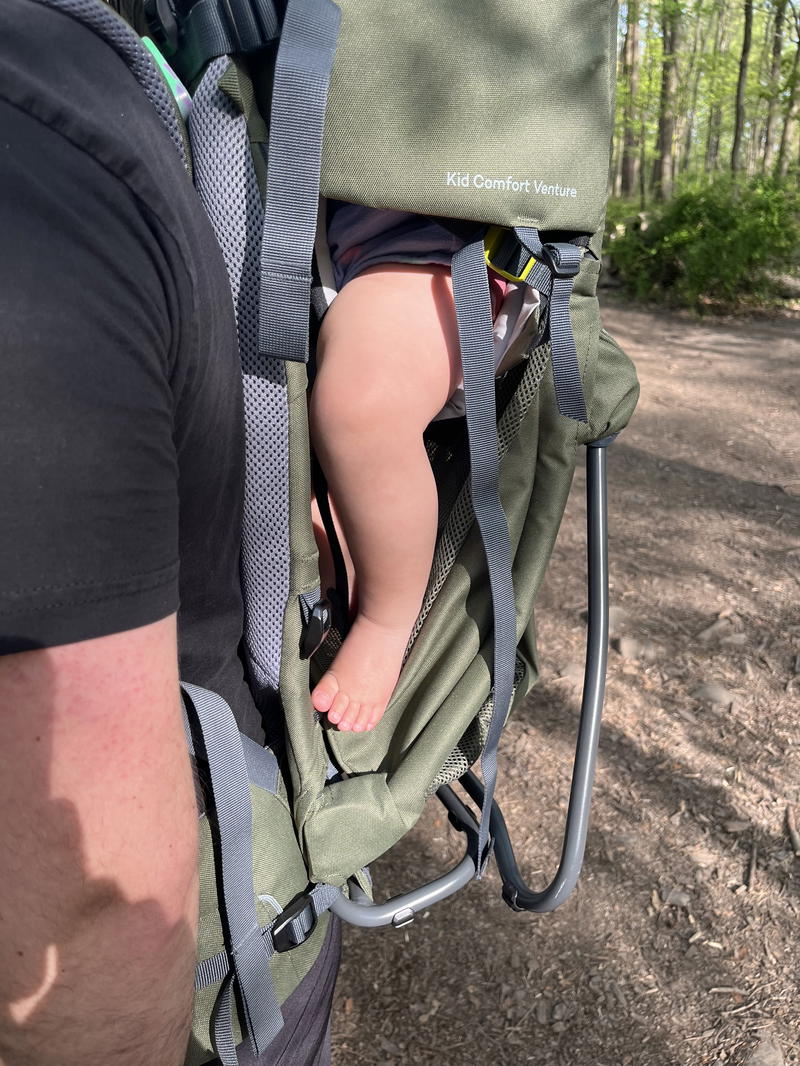
If you’re planning to do casual hiking and nature walks, I will confidently tell you that ANY of these baby hiking backpacks will give you great value for your money. They will also give you great value over time, meaning you could use them from your first kid to your fourth, with few signs of wear.
If you plan to do multi-day hikes and take one of these baby hiking carriers on a big hiking trip where you’ll be doing 6-10 miles a day by foot, yes: I would suggest investing in a higher or premiere model, rather than a basic one.
For everyone else, like us: a basic model of any leading brand’s baby hiking carrier will do an awesome job at transporting your child.
Reviews
We like to read reviews for anything we buy. Reading reviews for these baby hiking carriers will let you glimpse into what other parents think about the longevity of the carriers, any shortcomings they’ve found and what they think are indispensable features.
Features
At first, all child hiking carriers look the same. If you peel back the surface and look a little closer, you start to learn about the parts of them, like we have.
Some have built-in sunshades, and some do not. Some have super-adjustable frames that make better fits for petite or narrow-framed women like me (Deuter makes the “SL” model, with a “Women’s Fit”), and some do not.
Some have zippered back storage compartments and some don’t (our Deuter Kid Comfort does not, but you’d see that all the Osprey child carriers DO have zippered storage pockets for snacks and whatever else).
It depends what you want, and what you’re ready to pay for (see: Price).
Available accessories
Each brand has their own types of accessories available for these baby hiking carriers. For example, Osprey makes add-on sunshades and a rain cover for the Poco carriers. Deuter also makes what they call a “sun roof” (available at REI), as well as a Deluxe Rain Cover.
Even different yet, but also similar, Kelty makes a “Sunshade” for the Journey child carriers. Thule sells a rain cover for the Sapling carriers as well as a “Sling pack,” which is a backpack that inserts into the child carrier itself, for extra convenience and storage for parents. Wow!
You could look for ages and find the perfect accessories to go with your child hiking carrier. What’s good to know is that if you plan to go on a rainy trip, I’d choose a brand that makes a rain cover for their carrier (I see that only Kelty does not manufacture one of these for their carriers).
🎒 Found the right gear?
We research and test the gear we recommend, so you can pack with confidence. If our suggestions improved your gear picks, treating us to a coffee keeps the reviews coming.
Help us test more gearYou may also like
-
![A close up of the buckle on the baby tula lite carrier.]()
Baby Tula Lite Baby Carrier Review: Lightweight and Compact for Travel
I review the Baby Tula Carrier Lite as a travel product for babywearing during trips. Find out the special features that make this lightweight baby carrier ideal for on the go.
-
![]()
How to Baby-proof a Hotel Room or Airbnb (16 Tips)
Can you baby-proof or toddler-proof a hotel room, vacation rental or Airbnb? In these tips, see what I do when we travel so our child stays safe and out of travel on vacation.
-
![]()
Baby Tula Explore Carrier Review: Sturdy, Comfy and Supportive
I tested one of Baby Tula's most popular baby carriers, the Explore Carrier, because I wanted a front-facing carry option for my baby. Read my review, and find a discount code inside.
-
![]()
How to Survive Plane Travel with a Toddler (17 Tips for Parents)
How do real parents survive flying with a toddler? My friends and I pooled these tips for the easiest and smoothest plane travel with a toddler, from how to pass the time and how to stay calm.
-
![]()
Toddler Diaper Bag Essentials for Travel Days (What to Pack)
Traveling near, or far? You need a fully-stocked diaper bag for your toddler, with toddler essentials for every type of situation when you’re on the go! Here are my recommendations of must-haves and essentials for a day out.
-
![]()
10 Best Sound Machines for Travel (White Noise for Sleep)
These portable white noise machines for travel with babies, toddlers and kids are travel-sized and compact. See which one is best for sleeping and naps during a trip.
